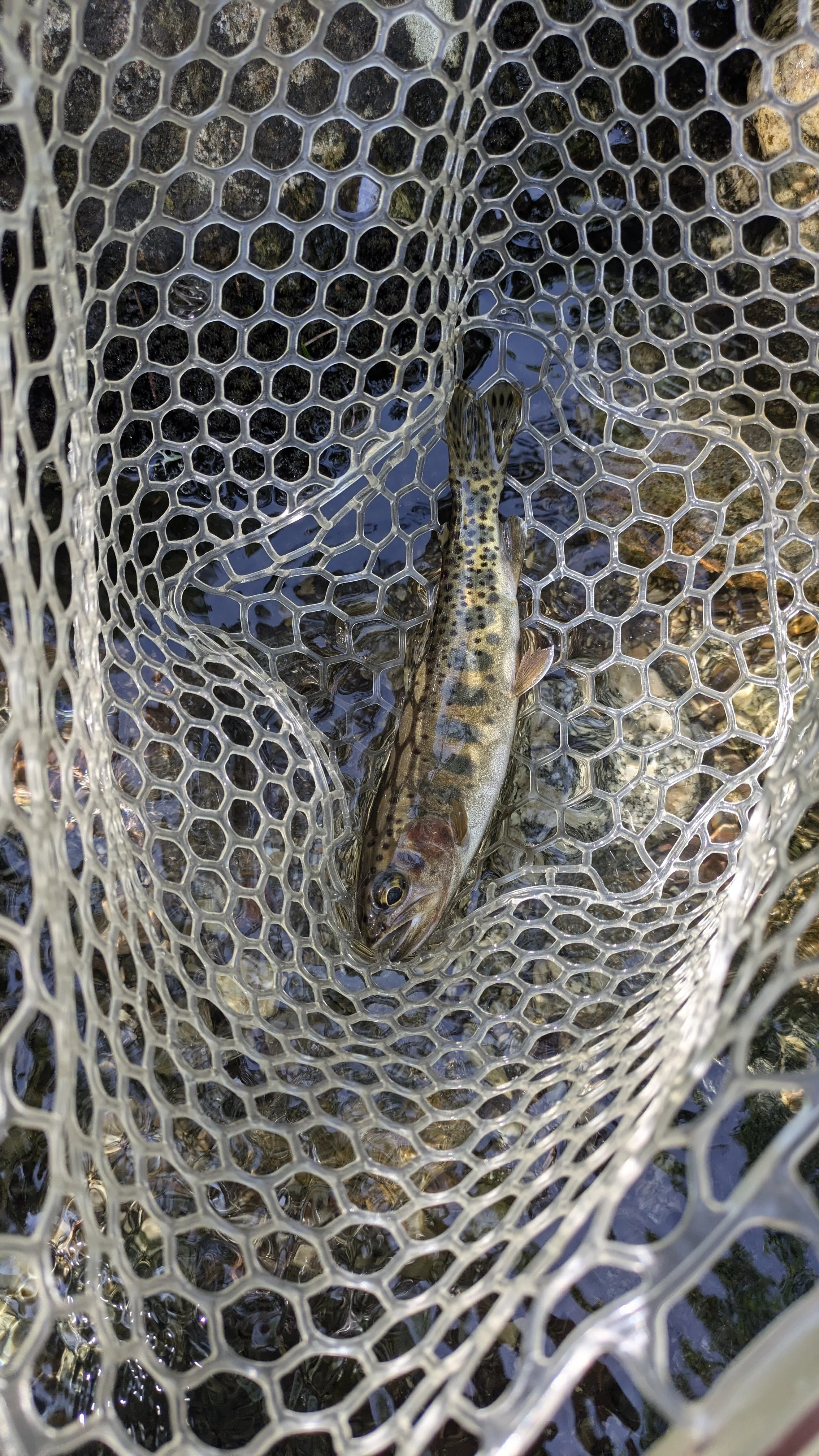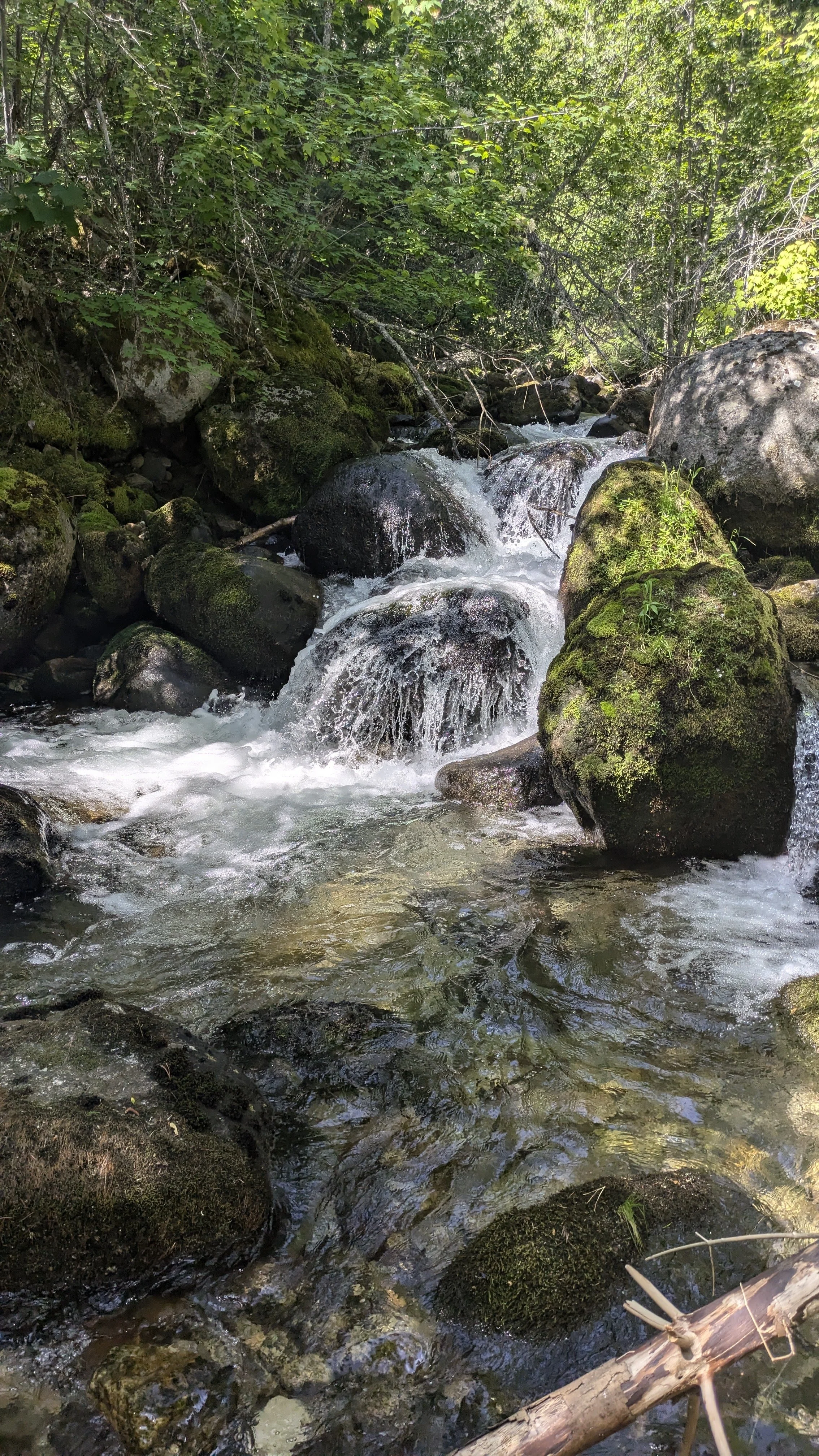
The average person just sees a bug. A fly fisher can see the caddis or the mayfly, the salmon fly and stonefly. They see a running current; at the same time a frightening, powerful phenomenon and a thing of beauty. A fly fisher sees the way the water curls over a large rock, the trout nearby waiting for the next course to their meal behind it. The fly fisher sees the water in a different way; it is a whole different experience. A better experience. It gently reminds us that we are part of the river, the ecosystem, the life cycle, nature itself. The river demands respect from us. Without it, the river cannot sustain.
A mountain bluebird chirps its nasally tew–a warning to the others–as I crunch through this past winter’s fallen pine branches on the approach to the river, a gentle bubbling of the water growing louder with each foot step. Above, a cerulean sky with the occasional sparse and wispy blanket of cirrus tell me it’s a fine morning for angling.
At the bank, a few flat rocks hold my pocket stove up on the stony shore as I pour a cup of coffee from my kettle. The bluebird chirps have grown from one to three. I am surrounded on all sides but where I am facing–the stream. It is close to 8 a.m. now, and the fish have been rising since I arrived. I grab a small fly out of the air. Very, very small baetis. I rig up the 4 weight that I brought along, tie on a small #20 olive-bodied BWO pattern, and finish my kuksa of coffee while picking some grounds out of my teeth.
The trout in this section of the stream have always been spooky. The tactic is to stay low. With the sun at my back, I cast my (and my rod’s) shadow towards the water. It is about stalking the fish here–a hunt. I watch for another rise and a good sized head breaks the surface tension and nabs something about fifteen feet in front of me on the edge of a seam. I let my line out and with two quick sidearm casts to reduce the chance the rod’s shadow will spook my target, I land the fly about ten yards above the feeding trout. As I drift, I mend the line a bit back out of the slight current in front of me to maximize the efficiency of the dead drift of my fly. I set the hook when the fish took it from the surface and after a short fight, a plump 9” cutthroat trout was in my net. The young trout is a thing of beauty. From dark bronze to light with par marks still visible on its side; a small god from the heavens that is this roaring wonderland.
Cutting through the trees wide to avoid marching straight through the creek, I see something unusual for the creeks of this area: a large pool. But not any ordinary large pool. The creek here widens to nearly two-and-a-half times its mean width and it is absent of nearly any hazards. The trees respectfully stand back from the banks and they keep their lower limbs outside of the creek from all sides. The far side of the bend moves slowly and gains a bit of speed on its way towards my position. It quickens as the creek splits on a large boulder which holds a decent looking pool with a backflow that I know will hold trout. Then, the coup de grace: a perfect, slow running seam full of small droplets of foam and a trout nose every fifteen seconds or so rising to God knows what. Unlike where I last fished, there is nothing in the air. Through binoculars, I still can't tell. I don't see anything but the snouts of rising trout.
There are two flies I tie on during times like these; two confidence flies that one of my fly boxes consist entirely of: the parachute Adams, and the standard small back ant pattern. If things are flying and I cannot distinguish what they are? Adams. If I do not see anything flying? Black ant.
Ant it is.
With each rising trout, I plan my attack. One snout, two snouts, three snouts, four. All about the same size as I can tell, small. Very typical for a creek this size, of course. Then, a dorsal fin followed by a tail rises up and comes to slurp the mystery bug from the surface. I set up a cast with my 3 weight Moonlit fiberglass rod and the fly lands a few feet above the trout. My fly is sucked into the water and I set the rod. In a few pulls, a fish is in my net: a small cutthroat. I release it back in and watch the seam. The big one rises again. Good, he is too hungry to spook. A few more casts, and each comes up empty.
Frustrated, I go back to my fly box. I could change to one of the Adams I have. But I crack another box, and a #14 elk hair caddis catches my eye. A classic; a fly I have only tossed on once before this year where it netted me a 16” rainbow from the Kootenai down by my house just days earlier. I replace the ant with the caddis, apply my floatant and whip a cast over to the seam. The next second, the fish jumps with my fly in its top lip and slams back into the water. It is not often that a creek fish in Boundary County makes a strong run on me, but my rod bends deep and I am constantly manipulating his course away from the boulders and the fast current rolling down stream.
Though the fight only took a minute, it seemed like ages. The howl of the water and the calls of the bluebirds are the soundtrack to the last stand. I have caught sizable stream-based cutthroat out of this hidden North Idaho gem in the past, but nothing like this. After successfully netting the fish, a 12” westslope cutthroat from the creek was looking up at me. This is what I fish for. One can fish the rivers and catch fish this size only to be disappointed it wasn’t a lunker. In a stream in Boundary County, this fish is a lunker. A thing of beauty. A true small god of the waters. The staple orange jaw slash, dark coloration of its bronze body, heavy spotting and its large par marks still intact. The fish swims off downstream as I let it go and I go up the bank to sit against the trunk of a large tree. A cool breeze pours down from the mountain and I inhale it deeply, the quivering forest whispering above me. The sun is overhead beating down on the stream, yet the water keeps its icy hold. I consider making another pot of coffee, but another larger trout rises.
Back in the water, I make another cast and lay the elk hair caddis delicately in the seam. Another take, another large 12” cutthroat in the net. Though this spot is producing, there is more to the creek that I have yet to lay my line out on and my time is running out. I pack up my gear and make my way up through the flowing waters, the cool stream comfortable in the rising temperatures pouring in through the trunks of large pine.
The next pool I stop at will be my last for the day, and it has always been the clincher for a great day of fishing. The pool produces. Water flows in quickly over boulders and rock shelves, falling into a deep pool that holds many trout that do not spooky easily. Basically, it is a guarantee to not get skunked on a trip all the way up these mountains (which, of course, I had no need for today). In the next ten minutes, I pulled out four 4-6” dinks and another trout pushing 12 inches.
I would go all day if I could, but damn the responsibilities of life, family, and work. I love them all, but these waters, these trout, and the wandering limbs of old growth pine are always trying to pull me away. I am blessed that I am able to get out as much as I am, but I always long for just one more cast.
And there will always be one more cast.
Tight lines out there, friends.

